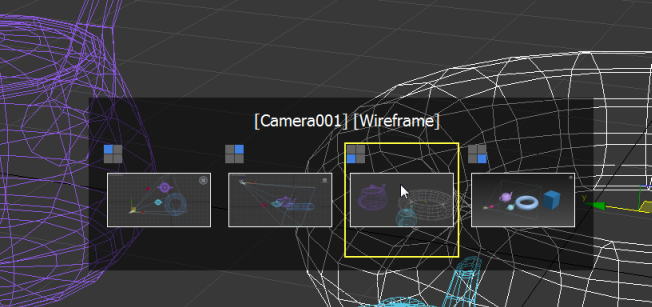You can customize your viewport layout, viewport rendering, display performance, as well as how objects are displayed by changing general configuration settings.
Active Viewport Borders
When multiple viewports are visible, one viewport, marked with a highlighted border, is always active. This is where commands and other actions take effect. For example, press Alt+W to toggle between maximizing the active viewport and viewing all available viewports.
Only one viewport at a time can be active. Other viewports are for observation only; unless disabled, they simultaneously track actions taken in the active viewport. When Auto Key or Set Key is on, the active viewport border changes to red.
In general, a viewport becomes active as you work in it. You can move an object in one viewport, and then drag the same object in another viewport to continue the move. To activate a viewport without changing the selection, right-click it. If you left-click a viewport, the viewport is activated and whatever you click is selected, or, if you click an empty area, everything is deselected. You can restore previous selections with Undo (Ctrl+Z).
Switching Viewports When Maximized
When a multi-viewport layout is active and a viewport is maximized (toggle with Alt+W), you can switch to other viewports in the layout by first pressing and holding the Windows key (sometimes labeled "Start") and then pressing and releasing the Shift key. This opens an overlay interface for switching to a different viewport:

Overlay interface for changing the maximized viewport
At this point, the next available viewport is highlighted. You can change the highlighting by pressing Shift repeatedly; releasing the key at any time maximizes the highlighted viewport. Alternatively, point to the desired viewport and click the mouse button.
Dynamic Resizing of Viewports
You can resize the four viewports so they are of unequal proportions. To do so, drag the intersection of two, three, or four viewports, on the splitter bars. To return to the original layout, right-click an intersection of the dividing lines and choose Reset Layout from the right-click menu.
The new viewport proportions are saved in the scene. However, changing the viewport layout always resets them.
World-Space Tripod
The three-color world-space tripod is visible in the lower-left corner of each viewport. The colors correspond to the three axes of world space: red=X, green=Y, and blue=Z. The axes are labeled in these same colors. The tripod always refers to world space, regardless of the current reference coordinate system.
The world-space tripod is on by default. To turn off this feature, see “To turn off the world-space tripod in all viewports” in the following procedures.
Viewport Tooltips for Object Names
When you’re working with objects in a viewport and pause the cursor over any unselected object, a tooltip appears with the name of that object. If you need to select something or link to something, wait until you see the tooltip to be sure you have selected the object you want. These tooltips are disabled when you work in sub-object mode.
Tooltips are on by default. To turn off this feature, see To turn off object name tooltips, below. For more information see Viewport Navigation and The 3ds Max Window.
Procedures
To make a viewport active, do one of the following:
- Click any viewport.
If you click an object in the viewport, it is selected. If you click a space where there are no objects, any selected objects are deselected.
- Right-click any viewport.
Right-clicking activates a viewport without changing the selection state of objects. (You can also do this by left-clicking the viewport label.)
- Use Windows/Start + Shift to cycle among the current viewports.
To switch between single and multiple viewports, do one of the following:
- Activate the viewport to minimize or maximize, then, on the keyboard, press Alt+W.
- Click Maximize Viewport Toggle in the lower-right corner of the 3ds Max window.
To change viewports when one is maximized:
- Press and hold Windows/Start, then press and release
Shift.
This opens the viewport-switching interface.
- If necessary, press
Shift repeatedly to highlight the desired viewport, then release Windows/Start to maximize the highlighted viewport.
Alternatively, simply click the desired viewport.
To resize the viewports:
- Drag the intersection of two, three, or four viewports to move the horizontal and vertical splitter bars.
- Move the intersection to any new location.
If you don't drag a corner, you can move the borders horizontally or vertically only.
- To reset the viewports, right-click an intersection and choose Reset Layout from the right-click menu.
To change the number of viewports and their arrangement:
- In any viewport, click or right-click the General viewport label ([+]). 3ds Max opens the General viewport menu. Choose Configure.
- On the Viewport Configuration dialog, click the Layout tab.
- Choose a layout from the choices at the top of the dialog.
- Assign what each viewport will display in the lower window of the dialog by clicking or right-clicking a viewport representation and choosing from the right-click menu.
- Click OK to make the change.
To turn off the world-space tripod in all viewports:
- Choose Customize menu
 Preferences to display the Preferences dialog.
Preferences to display the Preferences dialog.
- Click the Viewports tab.
- In the Viewport Parameters group, turn off Display World Axis.
- Click OK to make the change.
To turn off object-name tooltips:
- Choose Customize menu
 Preferences to display the Preferences dialog.
Preferences to display the Preferences dialog.
- Click the General tab.
- In the UI Display group, turn off Enable Viewport Tooltips.
- Click OK to make the change.